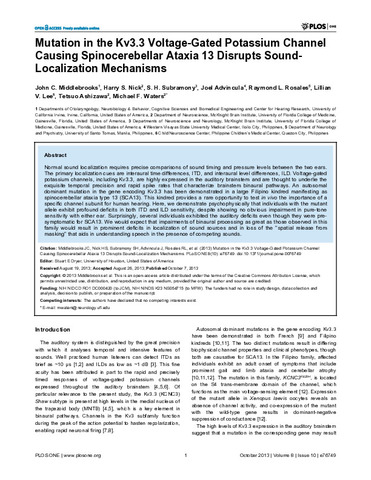Mutation in the kv3.3 voltage-gated potassium channel causing spinocerebellar ataxia 13 disrupts sound-localization mechanisms
| dc.contributor.author | Middlebrooks, John C. | |
| dc.contributor.author | Nick, Harry S. | |
| dc.contributor.author | Subramony, S H | |
| dc.contributor.author | Advincula, Joel | |
| dc.contributor.author | Rosales, Raymund L. | |
| dc.contributor.author | Lee, Lillian V. | |
| dc.contributor.author | Ashizawa, Tetsuo | |
| dc.contributor.author | Waters, Michael F. | |
| dc.date.accessioned | 2024-08-28T07:21:44Z | |
| dc.date.available | 2024-08-28T07:21:44Z | |
| dc.date.issued | 2013-10-07 | |
| dc.identifier.citation | Middlebrooks, J. C., Nick, H. S., Subramony, S. H., Advincula, J., Rosales, R. L., Lee, L. V., Ashizawa, T., & Waters, M. F. (2013) Mutation in the kv3.3 voltage-gated potassium channel causing spinocerebellar ataxia 13 disrupts sound-localization mechanisms. PLoS ONE, 8(10), https://doi.org/10.1371/journal.pone.0076749 | en |
| dc.identifier.issn | 1932-6203 | |
| dc.identifier.uri | https://hdl.handle.net/20.500.14353/642 | |
| dc.description.abstract | Normal sound localization requires precise comparisons of sound timing and pressure levels between the two ears. The primary localization cues are interaural time differences, ITD, and interaural level differences, ILD. Voltage-gated potassium channels, including Kv3.3, are highly expressed in the auditory brainstem and are thought to underlie the exquisite temporal precision and rapid spike rates that characterize brainstem binaural pathways. An autosomal dominant mutation in the gene encoding Kv3.3 has been demonstrated in a large Filipino kindred manifesting as spinocerebellar ataxia type 13 (SCA13). This kindred provides a rare opportunity to test in vivo the importance of a specific channel subunit for human hearing. Here, we demonstrate psychophysically that individuals with the mutant allele exhibit profound deficits in both ITD and ILD sensitivity, despite showing no obvious impairment in pure-tone sensitivity with either ear. Surprisingly, several individuals exhibited the auditory deficits even though they were pre-symptomatic for SCA13. We would expect that impairments of binaural processing as great as those observed in this family would result in prominent deficits in localization of sound sources and in loss of the "spatial release from masking" that aids in understanding speech in the presence of competing sounds. | en |
| dc.description.sponsorship | NIH NIDCD RO1 DC000420 (to JCM), NIH NINDS K23 NS054715 (to MFW). The funders had no role in study design, data collection and analysis, decision to publish, or preparation of the manuscript. | en |
| dc.language.iso | en | en |
| dc.publisher | Public Library of Science | en |
| dc.relation.uri | https://journals.plos.org/plosone/article?id=10.1371/journal.pone.0076749 | en |
| dc.subject | Spinocerebellar ataxia type 13 | en |
| dc.subject.lcsh | Ataxia | en |
| dc.subject.lcsh | Mutation (Biology) | en |
| dc.subject.lcsh | Brain stem | en |
| dc.subject.lcsh | Directional hearing | en |
| dc.subject.lcsh | Hearing | |
| dc.subject.lcsh | Mutation | |
| dc.subject.lcsh | ||
| dc.subject.lcsh | ||
| dc.subject.lcsh | ||
| dc.subject.lcsh | ||
| dc.title | Mutation in the kv3.3 voltage-gated potassium channel causing spinocerebellar ataxia 13 disrupts sound-localization mechanisms | en |
| dc.type | Article | en |
| dcterms.accessRights | Open access | en |
| dcterms.rights | Attribution 4.0 International | |
| dcterms.subject | Sound localization | |
| dcterms.subject | Auditory threshold | |
| dcterms.subject | Cues | |
| dcterms.subject | KCNC3 protein | |
| dcterms.subject | Spinocerebellar degenerations | |
| dcterms.subject | Spinocerebellar ataxias | |
| dcterms.subject | Signal transduction | |
| dcterms.subject | Shaw potassium channels | |
| dcterms.subject | Interaural time differences | |
| dcterms.subject | Interaural level differences | |
| dcterms.subject | Voltage-gated potassium channels | |
| dcterms.subject | Kv3.3 | |
| dcterms.subject | Human hearing | |
| dcterms.subject | Butterworth filters | |
| dcterms.subject | Action potential | |
| dcterms.subject | ||
| dcterms.subject | ||
| dc.citation.journaltitle | PLoS ONE | en |
| dc.citation.volume | 8 | en |
| dc.citation.issue | 10 | en |
| dc.citation.firstpage | e76749 | en |
| dc.identifier.doi | https://doi.org/10.1371/journal.pone.0076749 | |
| local.isIndexedBy | Scopus | en |
| dc.subject.sdg | SDG 3 - Good health and well-being | en |
Files in this item
This item appears in the following Collection(s)
-
Journal articles published externally [127]
Journal articles published externally, written by WVSU faculty members, staff, and students


